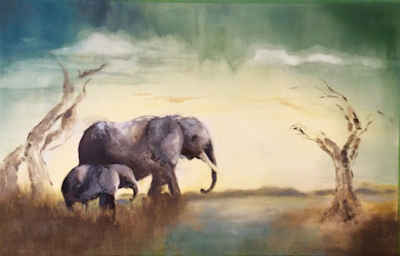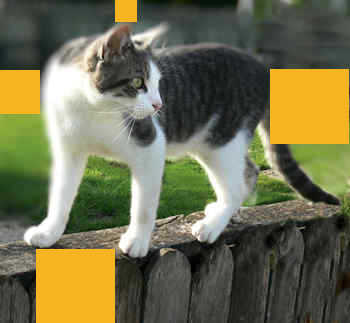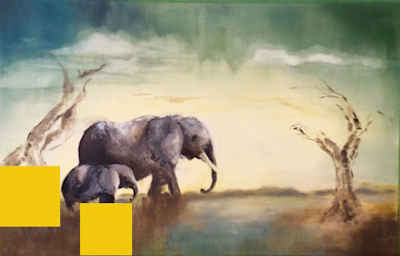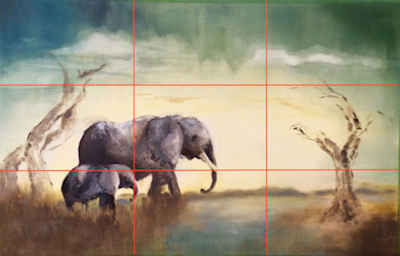Exposed! Story-telling Secrets In Subscriber's Art

Could you already be using some of the Story-telling Art Secrets in your work?
And not realize it?
I ask that, because of an experience I had a couple weeks ago. I'll tell you more about that in just a moment.
You'll remember that two weeks ago in this blog I related the story of your recent African safari adventure.
When the sudden appearance of an elephant herd made you totally forget your breakfast. And scramble to find your camera.
I used that story to stress how important Edges are to telling a good story in your art.
Well, the ink had barely dried on that post when subscriber Sandy Bogert emailed me saying:
"Thank you GARY!! Always love getting your newsletter/instruction..always very informative and this time terribly apropos....

It just happens that I finished a painting..unfortunately not in my head from some amazing African Safari...but saw a National Geographic picture of a herd of elephants and painted the attached..
Will now have to have a good look at it again to notice edges and what was really important to me?? Again thank you." (Sandy Bogert)
In the painting she included, I immediately noticed she had used all three types of edges.
Notice the hardest edges are in the stars of her picture. Since hard edges shout for your attention, that is often where you want hard edges.
But she doesn't make the mistake of making every edge in the elephants a hard edge. See how she softens the edge of the mother's back and forehead.

She also keeps the colors and edges of both the trees and the distant horizon softer.
So they don't fight for your attention. They remain less important than the stars.
Sandy also used Storytelling Art Secret #2 You Absolutely Need To Know.
I demonstrated that Secret in this blog, using your beloved cat, Bootsie.
I said by varying the space between your star and the edge of the art you help make your work more visually interesting.

Sandy did this with her elephants.
Notice how the distances around the elephants vary in every direction.
Now I didn't think to ask Sandy if she had done that consciously or only intuitively.
But, either way it happened, that positioning helps make the painting better.
And the last thing I noticed she had done was something I hadn't even mentioned in my blog post.

Though I may talk about it in the future.
An age-old method of designing a picture is the Rule of Thirds.
I won't go into a complete explanation now. But what this guideline says is: the places where my red lines cross are good areas to position your star.
Again, I didn't think to ask whether Sandy used the Rule of Thirds to place her elephants. Or whether it happened intuitively.
What do you think?
Best Wishes,
Gary Gumble
Founder of BeginningArtist.com
Without art the crudeness of reality would make the world unbearable. (George Bernard Shaw
P.S. The Story-telling Art Secrets I've mentioned over the last month and a half may seem like a lot to remember and deal with as you create art.
I would compare them to learning to drive.
Remember, when you first got behind the wheel, how hard it seemed?
All the things you had to remember and watch for? Other cars, how to brake, how to make a turn, speed limit signs, street signs, when to use your turn signal and on and on…
But gradually you learned to control the car, see all the signs and safely reach your destination.
Now all that stuff is easy.
Well, the same thing happens in art.
When you continually practice using all the Story-telling Secrets. (If you missed that series of posts, start reading about them here: Story-telling Art Secret #1.)
Copyright Gary Gumble 2023 All rights reserved About Privacy Policy Terms of Use Contact www.beginningartist.com 27 rue Roucher, 34000 Montpellier, France